This post may contain affiliate links. Please read our disclosure policy.
Learn how to make Authentic Pork Tamales using this easy to follow step by step guide! These tamales are filled with tender shredded pork coated in a homemade red Chile sauce. All covered with masa that is smooth, light and melt in your mouth.
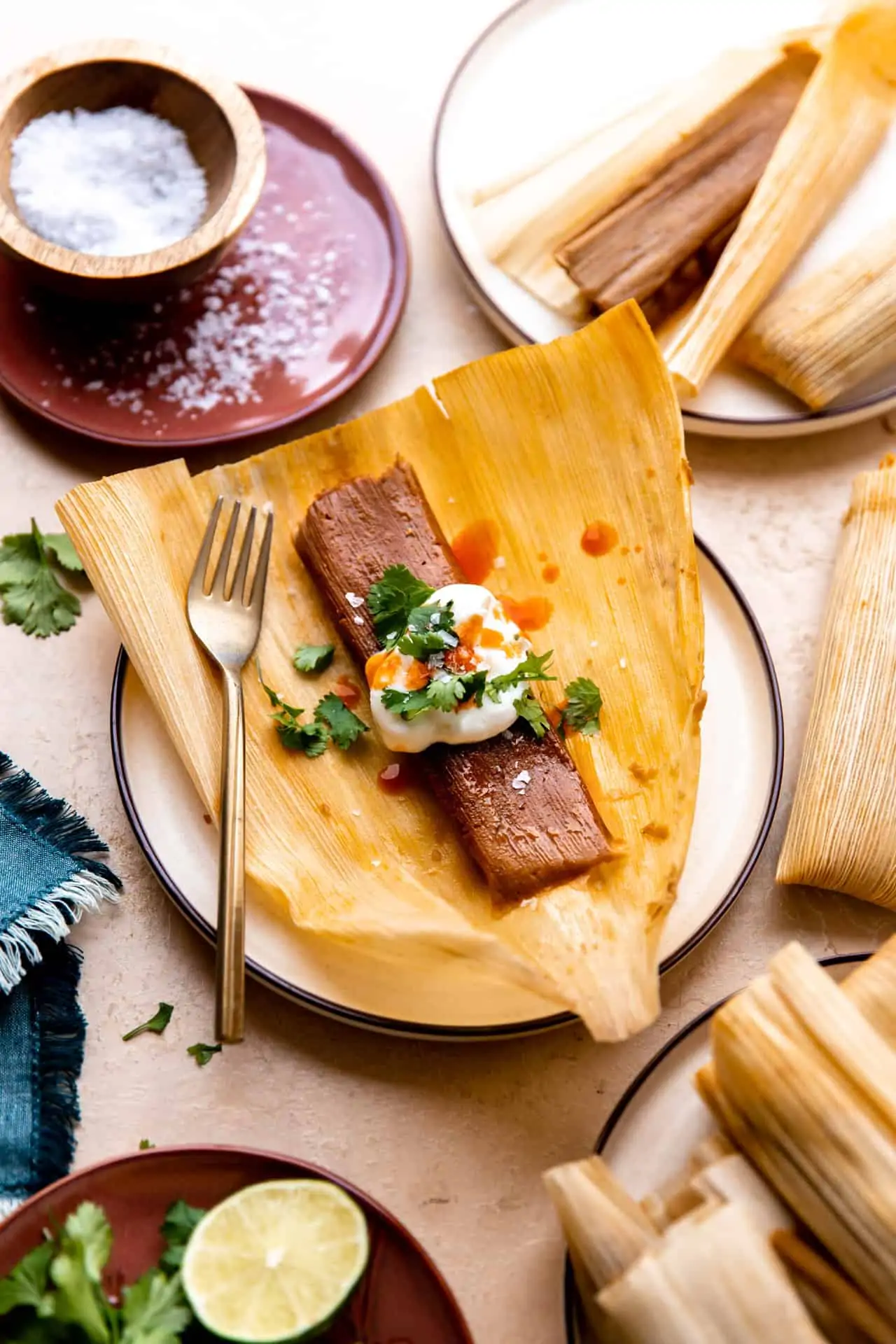
All about these pork tamales…
Tamales are a staple in Texas during the Christmas Season. Tamales are a traditional Mexican recipe with Aztec roots. Cooked meats, fruits, or vegetables are rolled inside of leaves or corn husks that have been smeared with a corn based dough mixture (masa). It is thought they were used as a portable food, something for people to grab and go. Now they are made to be enjoyed as a meal for special occasions!
Some reasons to love this recipe:
- Easy to make, but they can be time consuming. This is why this is a great recipe to get the family involved in! Grab some kids, friends, family and spend a couple hours spreading masa and assembling. Then enjoy a delicious meal together.
- Makes a lot. A little meat goes a long way, just using 4 lbs of pork we will be able to make 60-70 tamales. This is great if you are wanting to gift some, sell some, or freeze some!
- Traditions, I love family traditions. And this is a great one to implement. Making tamales during the Christmas season is a great way to spend time together, plus it’s a great way to connect to the culture around you or previous generations.
Ingredients Needed:
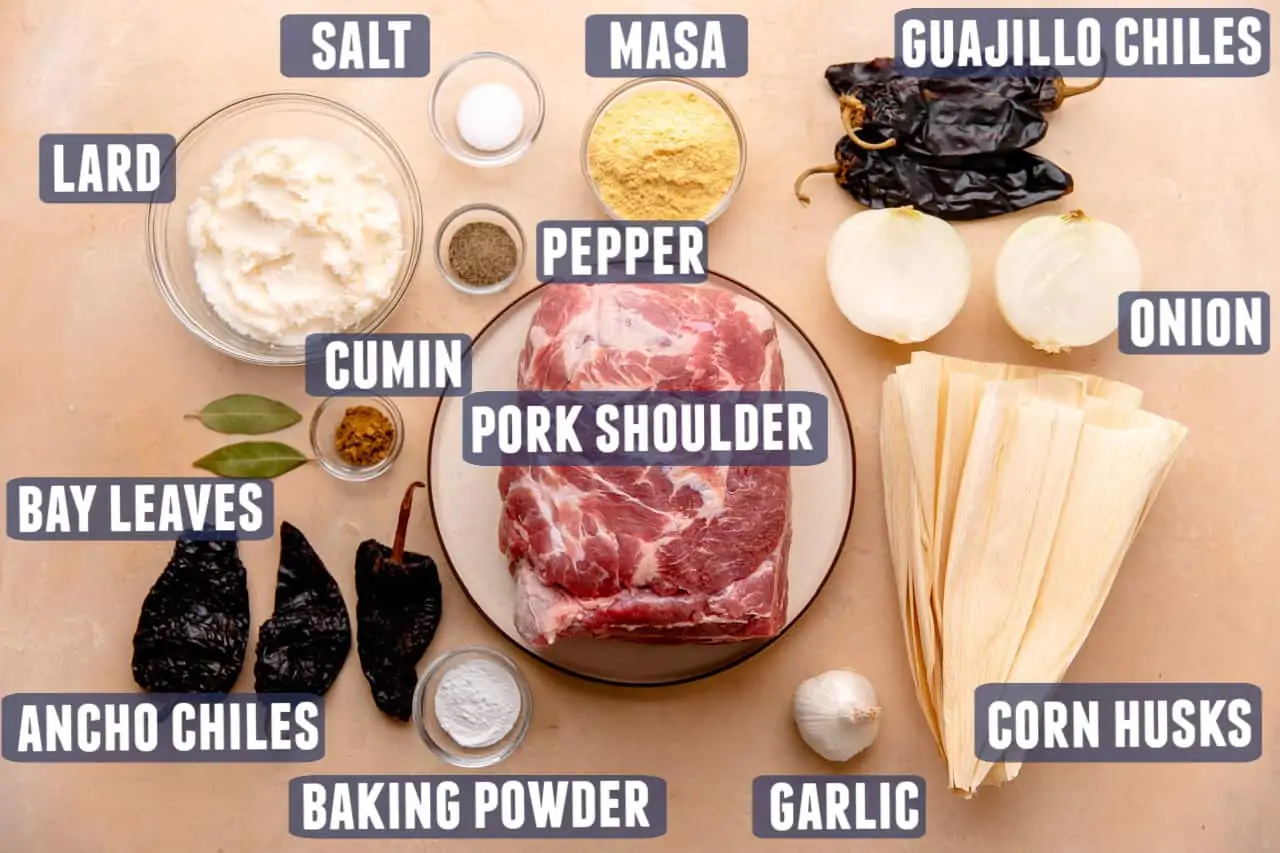
Notes on some ingredients:
- Masa: this is referring to the dry masa harina, or corn flour. My favorite brand is Maseca, it’s in the baking aisle next to the flours, and comes in a white package with green and yellow lettering. There are two kinds, you willl see a Maseca for Tamals, and a regular Maseca corn flour. The Maseca corn flour comes in yellow or white, either will work it’s preference. I typically will use white, but as you can see above this batch was made with yellow. The Masa for Tamals, has a larger grain size, but personally I like the smoothness I get from the regular corn flour. Again, it’s a preference. Any type will work.
- Lard: this is the fat that is used to create the masa dough. Lard has been given a bad name, but honestly, it’s just rendered pork fat. Which makes it natural when compared to some other options in the markets today. It gives a great consistency to our masa dough. Other options if needed would include: butter, shortening, cooking oil.
- Pork: pork shoulder, or pork butt (which are the same thing) bone-in is the best option. The bone is great for helping to create a nice broth, which we will be using. If you are unable to get a bone in, you could try using pig trotters, or ham hocks to help get some bone broth.
- Ancho Chiles: these are a dried poblano pepper, they have a sweet, mild flavoring. (1000-2000 SHU)
- Guajillo Chiles: another dried chile pepper. These are dried Marisol peppers, they also have a sweet, mild flavoring (2500-5000 SHU)
- Corn Husks: dried husks are typically sold in most markets during Christmas time, they can also be found year round in the Mexican aisles. If needed you could order online.
How to make (step-by-step):
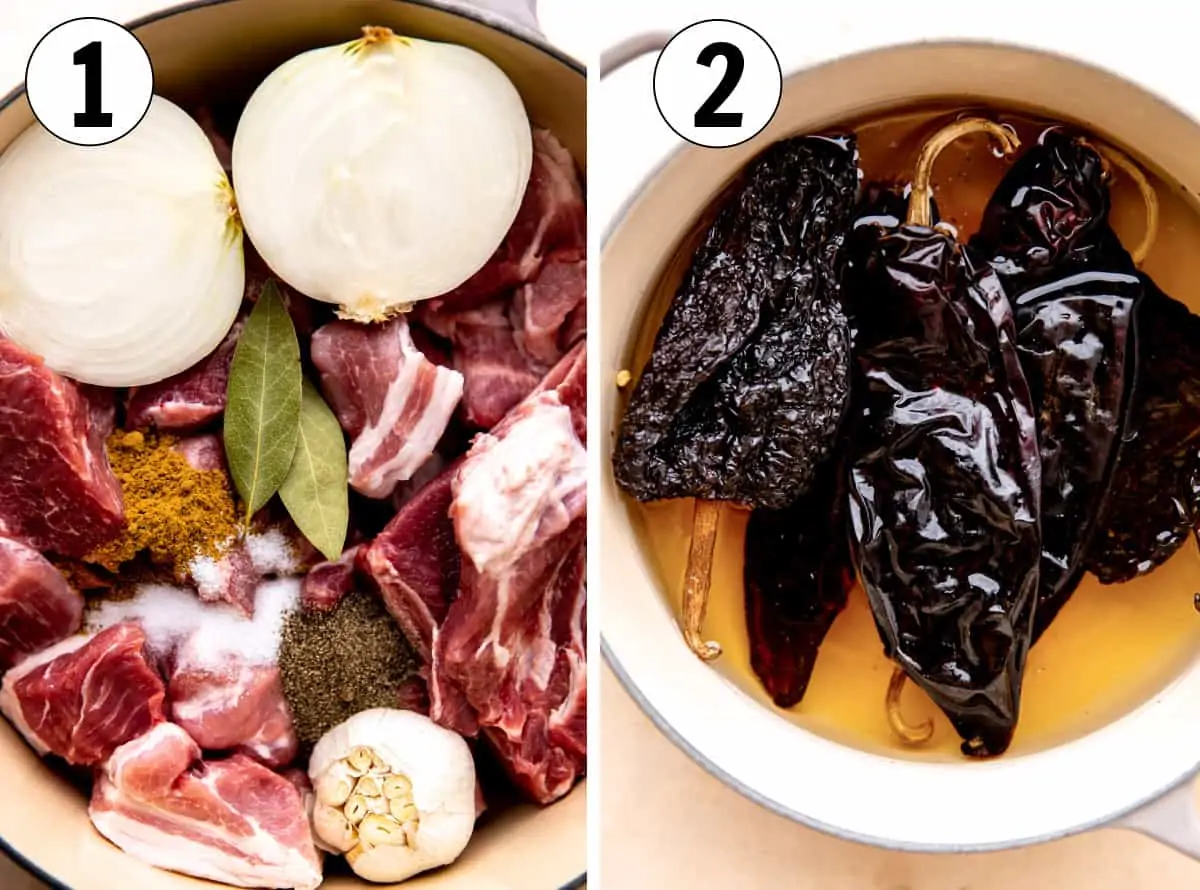
- Step 1: Prepare the pork and broth. Using a large pot add the roughly chopped pork, seasonings, and aromatics. Save everything from making the pork. The onion and the garlic will be used in the chile sauce. The broth will be used to make the masa dough.
- Step 2: Prepare the chile sauce by soaking the chiles in hot water, again save the water since this will be used in the actual chile sauce also.

- Step 3: Remove the cooked pork and shred, place the meat in a large container. If you are making this recipe in two days, you can store the meat in a sealed container in the refrigerator overnight. Be sure to save all the broth and the aromatics that you used also! The only thing we will dispose will be the bay leaves.
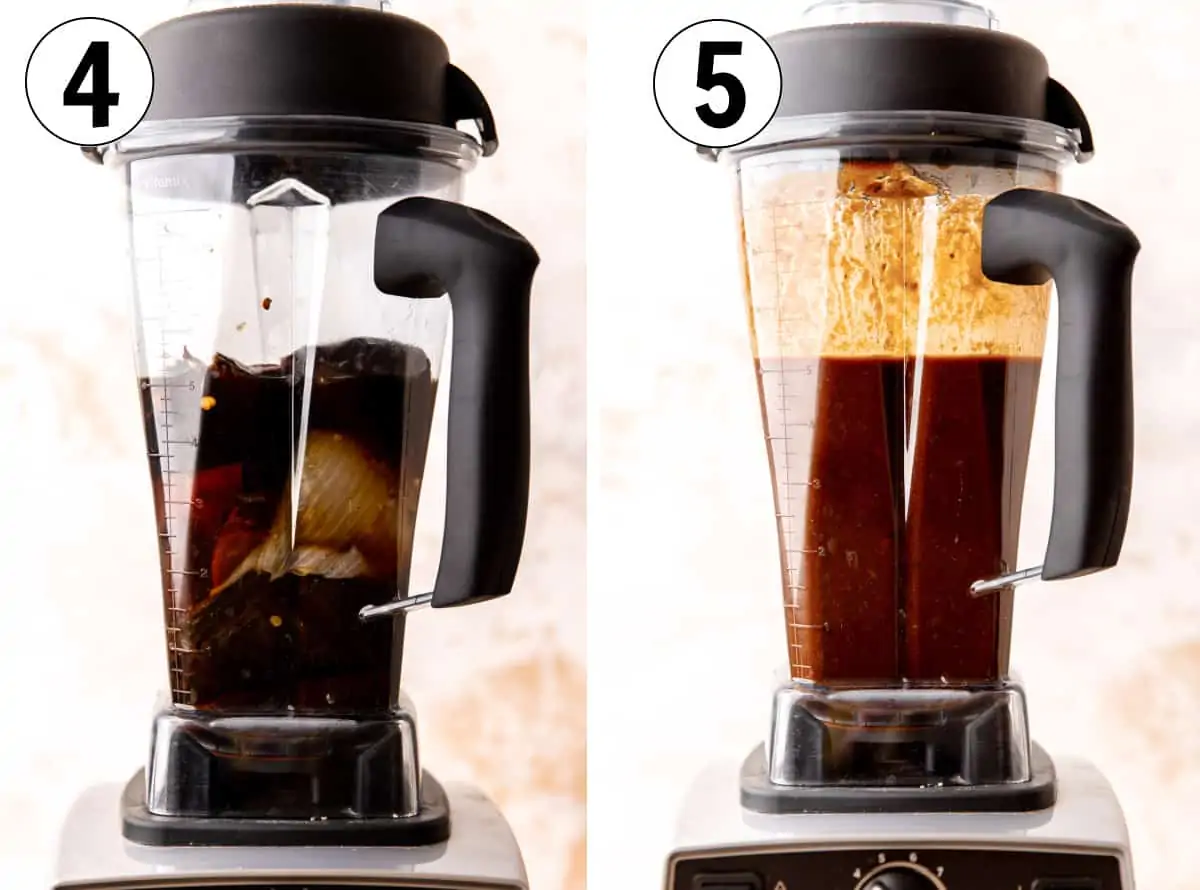
- Step 4: Place the softened chiles, the onion from the broth, and the garlic from the broth in a blender and blend with some of the pork broth and some of the water from soaking the chiles. Add a little salt and cumin for flavoring.
- Step 5: Blend until this is completely smooth. If needed run through a fine mesh strainer to get all the tough bits of skin out of your sauce. I find this unnecessary if using a high powered blender.
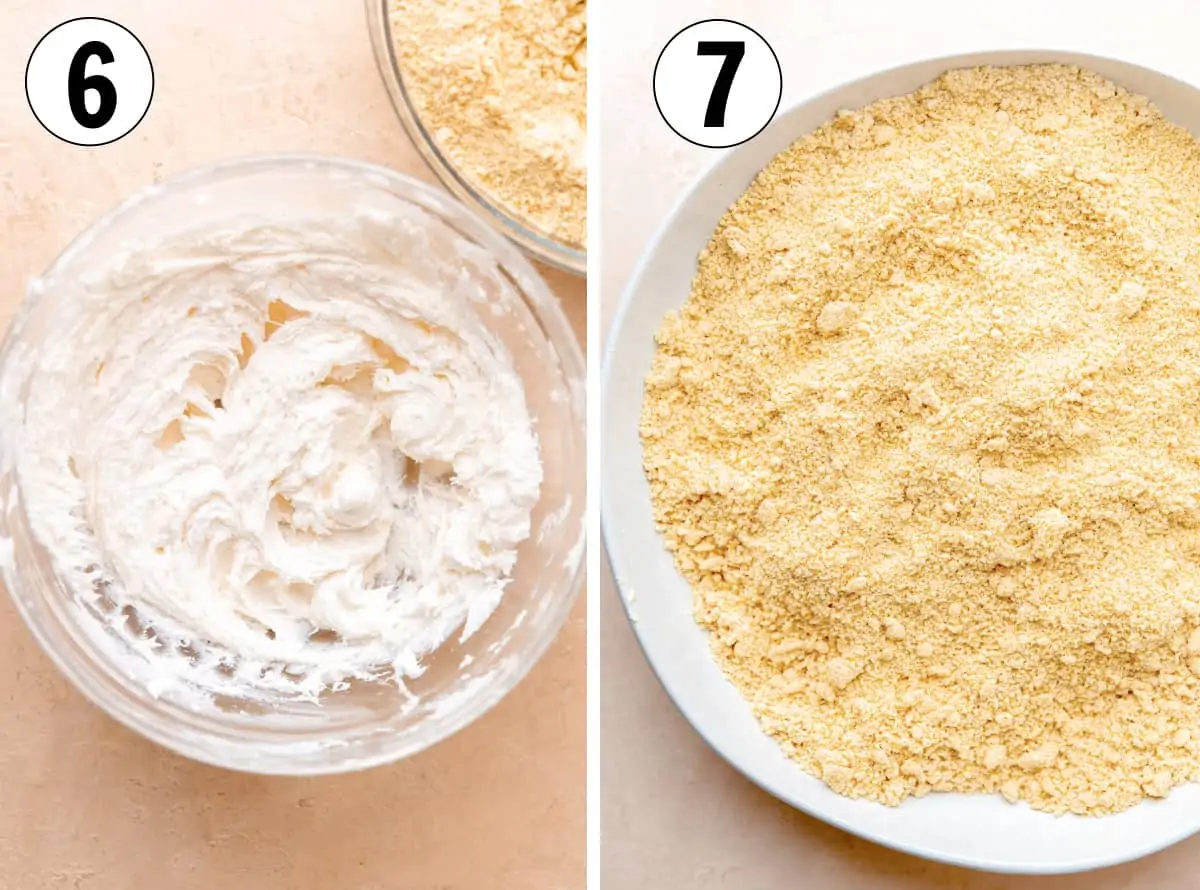
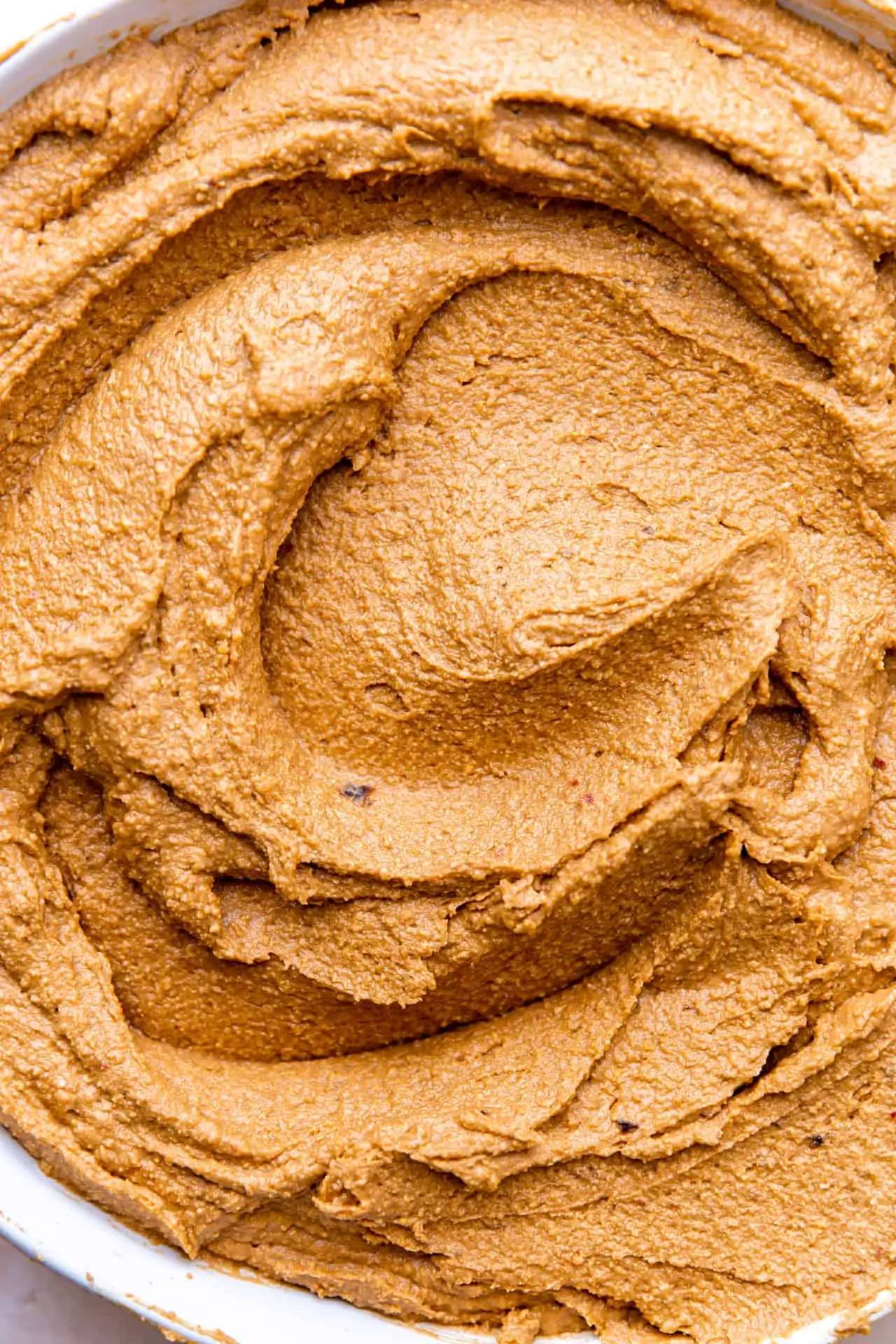
- Step 6: Whip the lard, using a hand or stand mixer, until it is light and fluffy. It will have a smooth and airy texture to it.
- Step 7: Using your fingers combine the lard with the corn flour until it resembles coarse meal.
- Step 8:Add in the remaining chile sauce, and pour in cups of the pork broth (they should be warm but not too hot to burn your hands), mixing with your hands until the masa is nicely hydrated and feels almost like a creamy mashed potato texture. It should spread smoothly. If you run out of pork broth, use some warmed up chicken broth.
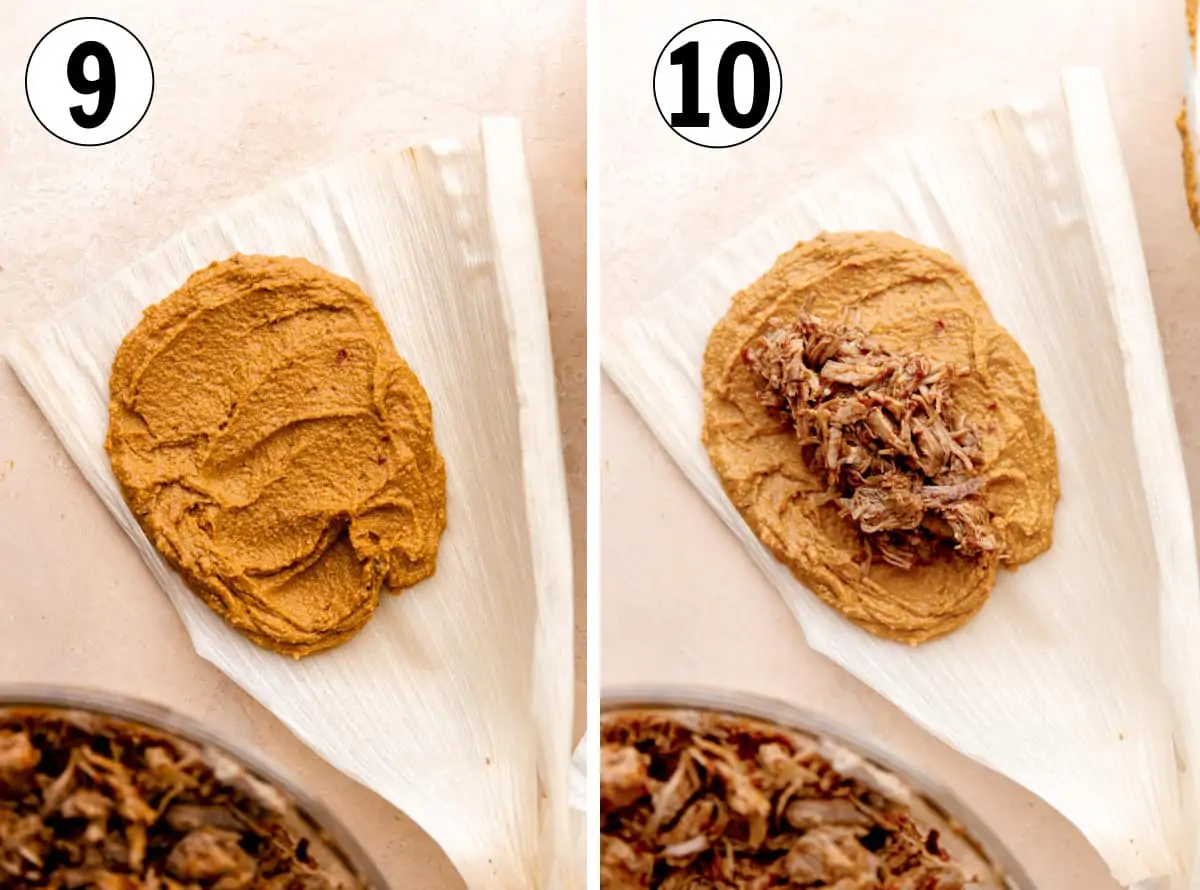
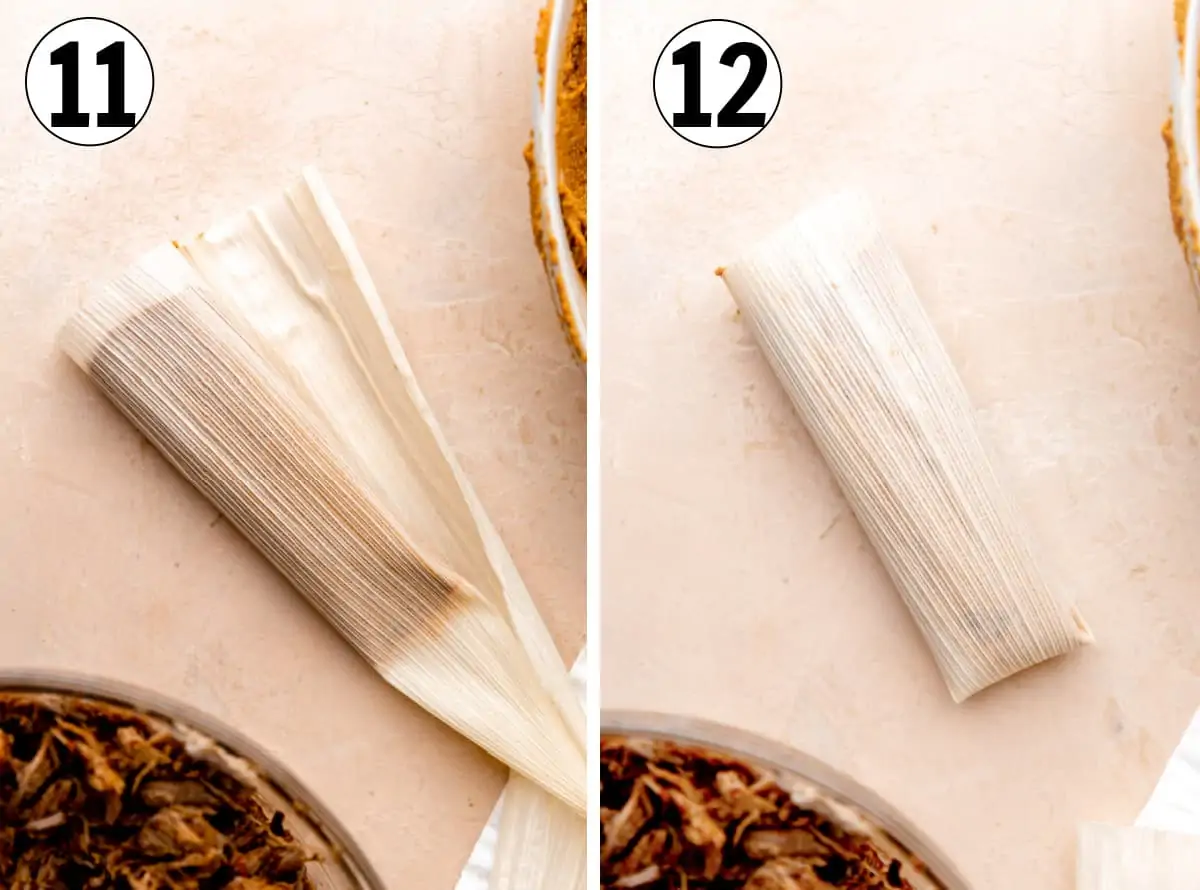
- Steps 9-13: Assemble the tamales. Pat the corn husk dry to remove any excess water. Spread the masa on the widest part of the corn husk. If the masa is slipping off of the husk, it is too warm, let it cool down. Then add 1-2 tablespoons of meat in the center of the masa and roll the corn husk over and fold up the bottom. Continue until all the tamales are rolled.
- Step 14: Place the rolled tamales in the steamer. Place one tamale on the bottom of the steamer basket, and then stack the remaining moving around almost like building a campfire out of wood. Top the tamales with some leftover corn husks to prevent condensation from dripping, then cover with the lid and steam for 1.5-2 hours.
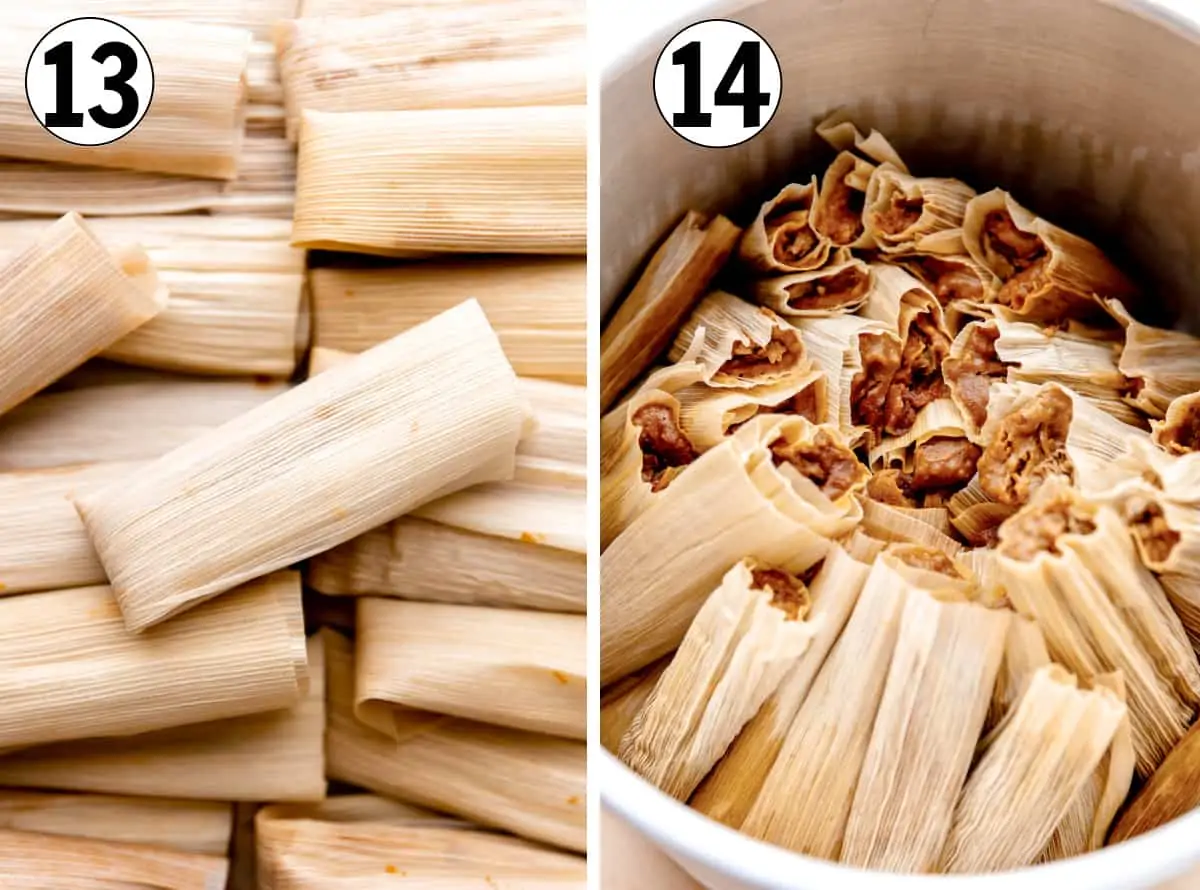
Expert Tips:
- Save everything from making the pork. The onion and the garlic will be used in the Chile sauce. The broth will be used to make the masa dough.
- This recipe is easiest to do in 2 days. Using one day to prepare meat and the Chile sauce. Then the second day to assemble the tamales.
- Assembly will be when you want someone to help out! Tamales aren’t difficult, but they are time consuming. Have some family, children or friends come and help spread the masa.
- Have some extra chicken broth on hand if needed for making the masa, depending on how much water you can fit in your pot with the pork, you may need a little extra liquid.
- If you are doing this in 2 days, don’t mix the chile sauce with the pork, just store everything separately. Then add the pork to a skillet, heat over low and stir in the chile sauce. Warm the broth, don’t remove any of the fat from the broth from it cooling, use it all. And warm the chile sauce also, they all need to be warm for making the masa dough
FAQ’s:
First of all, I want to tell you that lard is a great option. It’s simply rendered pork fat, which means it’s a ‘clean’ cooking fat. Clean here meaning there’s nothing added to it, it’s natural. However, if you would prefer to use something else, other options would include unsalted butter, cooking oil (avoid olive oils due to strong flavoring), or shortening.
Simply unwrap the corn husk and dispose of it. Serve up the tamales with a little sour cream and hot sauce. Or you can enjoy them all on their own, they’re plenty flavorful.
To retain the moisture in the masa the best option is to steam them again. Place in a steamer pot and steam for 20-30 minutes until warmed through. Or you can wrap them in a damp paper towel and microwave until warmed.
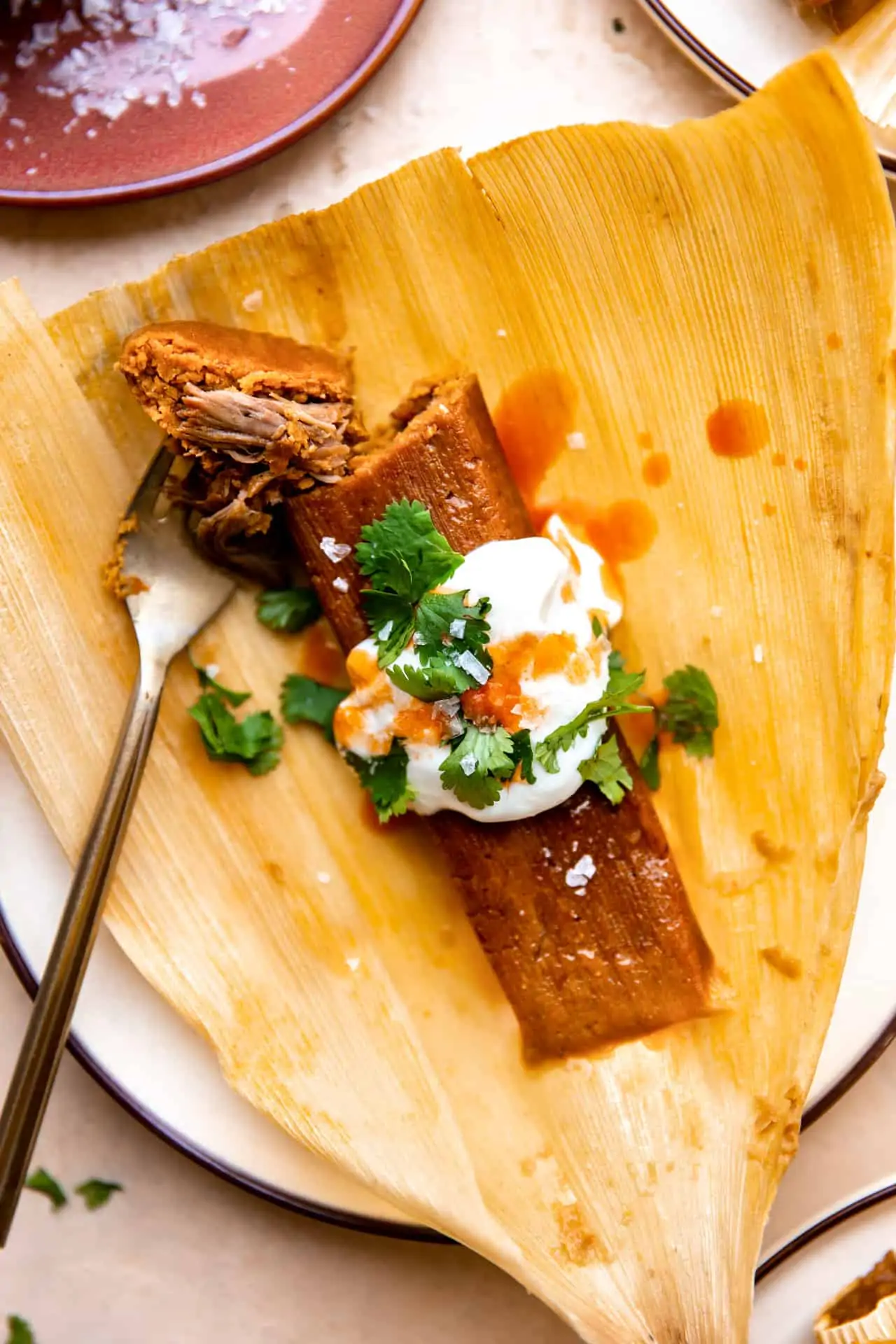
More Authentic Mexican Recipes:
- Beef Birria and Birria Tacos
- Authentic Carne Asada
- Mexican Street Corn Cups
- Mexican Picadillo
- Pork Carnitas
Pork Tamales
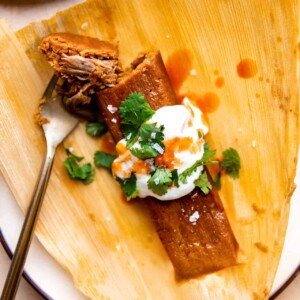
Ingredients
- 70 corn husks
Pork
Red Chile Sauce
- 3 guajillo peppers stems and seeds removed
- 3 ancho Chile peppers stems and seeds removed
- 1 tsp ground cumin
- ¼ tsp salt
- onion from pork broth cut off ends
- garlic bulb from pork broth squeeze out the cloves
- 1 cup pork broth
- 1 cup Chile broth from soaking peppers
Masa
- 8 ounces lard
- 1 tbsp baking powder
- 1 tbsp salt
- 2 lbs masa harina corn flour
- 1 cup red chile sauce recipe included
Instructions
Pork
- Cut the pork into 2 inch chunks and add to a large pot (5 qt). Don’t remove any of the fat or the bone. Add all of the pork and bone into the pot.
- Cover with water.
- Add in the onion, garlic, bayleaves, salt, cumin and pepper. Stir to combine.
- Turn heat to medium and bring to a boil.
- After several minutes of boiling, using a spoon, remove the impurities from boiling the bone (it will look like foam on the top of the liquid). If no bone, skip this step.
- Cover and reduce heat to medium low and let simmer for 2-3 hours until meat is cooked through and easily shreds.
- Remove the meat from the pot to a cutting board and shred. Then place in a large dish or bowl.
- Remove the onion and garlic from the pot and set aside.
- Remove the bone and discard.
- Place a strainer over a large bowl/pitcher, and pour the broth through the strainer to remove all other debris from the broth
- Pour broth back into the pot through a fine mesh strainer to remove all small bits remaining. Set the broth aside.
Red Chile Sauce
- Place the chiles in a medium size pot and cover with water.
- Cook over medium heat to bring to a boil.
- Cover and remove from heat. Let the chiles sit for 10-15 minutes until completely softened.
- Remove the chiles and place in a blender, add cumin and salt, add in the onion and garlic from the pork. Pour in the broth from soaking the chiles and the broth from the pork.
- Blend until sauce is completely smooth. (Be careful due to the hot liquids)
- Pour one cup of the red Chile sauce into the shredded pork and stir to combine.
Masa
- Add the lard to a large mixing bowl.
- Mix on high speed using a hand mixer for 3-4 minutes, this will whip the lard, it will have a light fluffy texture.
- Add in the salt and baking powder.
- Pour in the masa harina.
- Using your hands combine the dry ingredients into the fat until it is a coarse meal texture.
- Pour the remaining Chile sauce (be careful if it is still hot since you are mixing with your hands).
- Mix this together with your hands until incorporated.
- Pour in several cups of the pork broth and continue mixing with your hands until well combined. (When adding the broth, ensure that it is warm, not hot to burn your hands but we want the masa to be a nice warm temperature. If the masa is too hot it will slip off of the corn husks when you attempt to spread it. If needing to use extra chicken broth, take the time to heat up the broth before adding it in. )
- Continue adding broth as needed until the masa is smooth and spreadable. It shouldn’t feel dry. It will feel like creamy mashed potatoes. (if you run out of pork broth, this is where the extra chicken broth comes in handy!)
Assembly
- Two hours before assembly time add the corn husks to a large bowl and cover with water. If needed place a pot lid on top to press them down into the water.
- Prepare steamer pot by adding water to the bottom and placing the steamer rack on top.
- Remove the corn husks from the water. Discard the water. Lay the husks on a clean kitchen towel.
- Taking one corn husk, pat it dry on a towel to remove excess water. Lay it down with the smooth side facing up (the side with more pronounced ridges will be facing down).
- Scoop about 2-3 tablespoons of the masa dough onto the wider end of the husk and smooth out about 3/4 up the length of the corn husk (tools that work well are the back of a spoon, a small silicone spatula, or a plastic child’s knife). Smooth out a nice even layer of approximately 1/4 inch thick over the widest end of the corn husk, leaving 1/2 an inch on one side empty (this helps when it comes time to roll) and the narrow end of the husk empty.
- Spoon approximately 2 tablespoons of the pork meat onto the masa dough, a little off centered, towards the side that is completely covered with masa.
- Fold over the corn husk, to the side with no dough, then slightly tuck the end to seal the masa trapping the filling inside.
- Then fold over the bottom (the narrow empty end of the husk). There is no need to tie them..it takes too much time..
- Place the first tamale into your steamer pot directly in the center laying fold side down.
- Then continue assembling the tamales and placing them around the first tamale facing up, almost like building a campfire pyramid shape.
- Once all tamales have been made and are in the steamer cover them with some additional corn husks (this helps prevent condensation from dripping onto them during steaming). Then place the lid on top.
- Heat over medium heat until you can hear the water boiling in the pot. Then turn the heat to low and continue steaming for 1.5-2 hours.
- To check the done-ness of the tamales, remove one from the pot and remove the husk, if the masa dough removes easily from the husk without coming apart, or being too soft, then they are done. When tasting, if the masa is still a bit grainy in texture, continue steaming until it has a smooth texture.
Video
Equipment
Notes
- Masa: this is referring to the dry masa harina, or corn flour. My favorite brand is Maseca. There are two kinds, Maseca for Tamals, and a regular Maseca corn flour. The Maseca corn flour comes in yellow or white, either will work. The Masa for Tamals, has a larger grain size, but personally I like the smoothness I get from the regular corn flour.
- Lard: this is the fat that is used to create the masa dough. Other options if needed would include: unsalted butter, shortening, cooking oil (minus olive oils due to heavy flavoring).
- Pork: pork shoulder, or pork butt, bone-in is the best option. The bone is great for helping to create a nice broth, which we will be using. If you are unable to get a bone in, you could try using pig trotters, or ham hocks to help get some bone broth.
- Save everything from making the pork. The onion and the garlic will be used in the chile sauce. The broth will be used to make the masa dough.
- This recipe is easiest to do in 2 days. Using one day to prepare meat and the Chile sauce. Then the second day to assemble the tamales.
- Assembly will be when you want someone to help out!
- Have some extra chicken broth on hand if needed for making the masa, depending on how much water you can fit in your pot with the pork, you may need a little extra liquid.
- If you are doing this in 2 days, don’t mix the chile sauce with the pork, just store everything separately. Then add the pork to a skillet, heat over low and stir in the chile sauce. Warm the broth, don’t remove any of the fat from the broth from it cooling, use it all. And warm the chile sauce also, they all need to be warm for making the masa dough.
- Storage & Freezing: store tamales in a sealed container in the refrigerator for up to 1 week. Or store in the freezer in a freezer safe container for 3-4 months. To reheat steam the tamales for 20-30 minutes until warmed through.
Nutrition
Nutrition information is automatically calculated, so should only be used as an approximation.
Photography done by the talented @KJandCompany.co
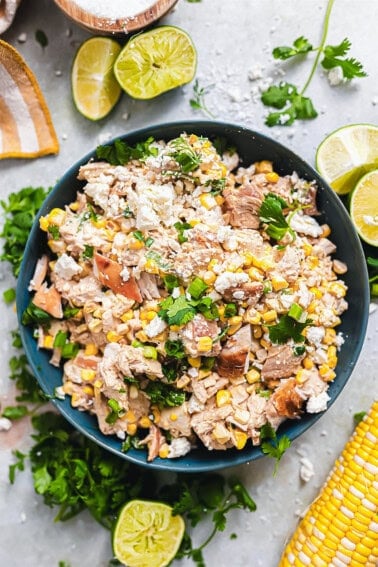
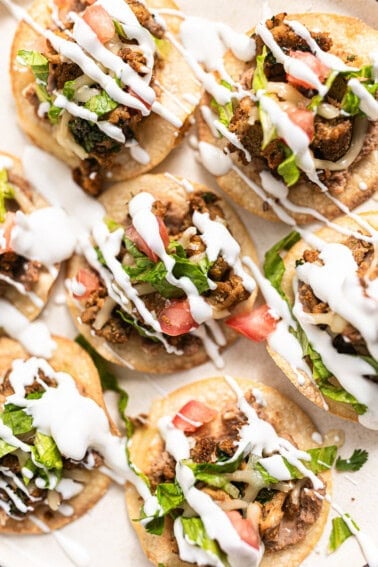


What chilies can I use for pork tamalies that won’t be too spicy for my little ones?
Both of the chiles used in this recipe are very mild, the ancho has a SHU of 1,000 while the Guajillo has 2,500. To give perspective, a jalapeño has 2,500-8,000. If you are concerned about the heat, you can leave out the Guajillo and strictly make these with Ancho peppers. Due to the amount of meat and the masa layer, there is not much if any heat to this recipe.
I really appreciate this walk through and the actual recipe, wouldn’t have had the confidence to try it with the pictures, the pictures are so much better than a video, kinda unexpectedly, I just like being able to see still shots of the essential stuff, so thank you!
Thank you so much Sabrina, I hope you give them a try! Once you make them you will be much more confident the next time around. They are worth the effort!